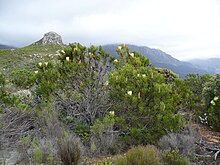
Back Protea Afrikaans بروطيا Arabic بروطيا ARZ Proteya Azerbaijani Protea Catalan Protea CEB Protea Czech Zuckerbüsche German Πρωτέα (φυτό) Greek Proteo (planto) Esperanto
| Protea | |
|---|---|

| |
| The original South African "suikerbossie" (sugarbush) Protea repens | |
| Scientific classification | |
| Kingdom: | Plantae |
| Clade: | Tracheophytes |
| Clade: | Angiosperms |
| Clade: | Eudicots |
| Order: | Proteales |
| Family: | Proteaceae |
| Subfamily: | Proteoideae |
| Tribe: | Proteeae |
| Genus: | Protea L. (1771), nom. cons. |
| Species | |
| Synonyms[1] | |
| |
Protea (/ˈproʊtiːə/[2]) is a genus of South African flowering plants, also called sugarbushes (Afrikaans: suikerbos). It is the type genus of the Proteaceae family.[3]
About 92% of the species occur only in the Cape Floristic Region, a narrow belt of mountainous coastal land from Clanwilliam to Grahamstown, South Africa. Most protea species are found south of the Limpopo River. Protea madiensis grows in Afromontane enclaves across tropical Africa, from Guinea to Sudan, Mozambique, and Angola.[4] Protea caffra ranges from the Cape region to Uganda and Kenya, including in the chaparral zone of Mount Kenya National Park. The extraordinary richness and diversity of species characteristic of the Cape flora are thought to be caused in part by the diverse landscape, where populations can become isolated from each other and in time develop into separate species.
- ^ Protea L.] Plants of the World Online. Retrieved 27 September 2023.
- ^ "Protea". Oxford English Dictionary (Online ed.). Oxford University Press. (Subscription or participating institution membership required.)
Sunset Western Garden Book, 1995:606–607 - ^ "Protea L." Plants of the World Online. Royal Botanic Gardens, Kew. 2023. Retrieved 25 September 2023.
- ^ Protea madiensis Oliv. Plants of the World Online. Retrieved 27 September 2023].